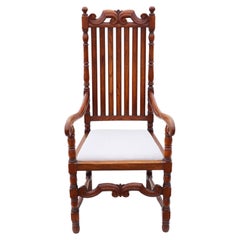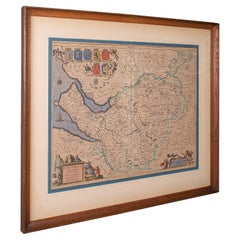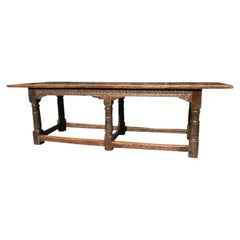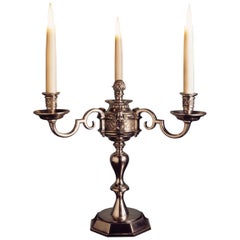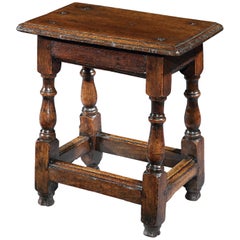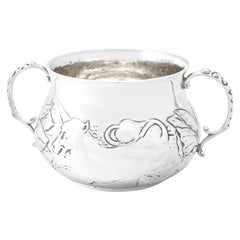Charles II Furniture
to
8
90
51
140
4
2
199,457
113,979
43,747
33,638
16,390
12,288
10,845
10,811
9,930
8,995
7,254
6,768
6,439
6,384
6,152
5,869
4,927
3,784
115
11
14
6
8
1
3
2
2
1
1
2
97
67
44
20
19
128
118
87
4
2
146
143
146
5
2
1
1
1
Style: Charles II
Antique Oak Armchair Elbow Desk Chair Charles II Style
Located in Wisbech, Cambridgeshire
Antique quality oak armchair elbow desk chair C1915, in the style of Charles II.
Solid, heavy and strong, with no loose joints or woodworm. Full of age, character and charm. A ver...
Category
1910s Vintage Charles II Furniture
Materials
Oak
Antique County Map of Cheshire, Dutch, Framed, Cartography, Janssonius, C.1660
Located in Hele, Devon, GB
This is an antique county map of Cheshire. A Dutch, framed atlas engraving by Johannes Janssonius, dating to the 17th century and later.
A treat for the collector or county native,...
Category
Mid-17th Century Dutch Antique Charles II Furniture
Materials
Glass, Wood, Paper
17th Century Oak Refectory Table, Charles II Period
Located in Lymington, GB
A rare English 17th-century oak refectory table. Charles II-period, ca 1675.
The three-plank cleated detachable top is of superb color, figuring and patination.
Raised on six baluster supports united by stretchers.
The frieze is guilloche-carved on all four sides: this demonstrates that this table can be free-standing. Many of these were only carved on three sides.
This versatile refectory table can be used as a hall table, dining table, serving table, or a wonderful kitchen table. A number of early oak pieces which we have sold have harmonized very well with modern interiors.
A similar-sized refectory table (in generally poor condition) sold for £17,000.00 plus buyer's premium, in Duke's auctioneers ATHELHAMPTON HOUSE sale, Puddletown, Dorset, UK, 9th Oct, 2019.
Nb. The turning of the supports on this antique table indicates a development away from an earlier, heavy, carved bulbous leg, to a simpler baluster leg of the late-seventeenth century. However the guilloche-carved frieze is a hint of an earlier period.
Some historic restoration commensurate with 350 years of use. Overall in superb condition.
Dimensions:
8’5’' L. (256.5 cm)
2’8’' W. (81 cm)
2'7'’ H. (79 cm).
Literature:
R. W. Symonds 'The Present State of Old English Furniture...
Category
1670s Antique Charles II Furniture
Materials
Oak
Candelabra, 20th Century, English, Charles II Style, Silver Plated, Knole
Located in BUNGAY, SUFFOLK
This was adapted from the silver chandelier hanging at Knole in Kent, exclusively for use in a conservation project at Hampton Court. It has an antique, silver plated finish. There i...
Category
1990s Charles II Furniture
Materials
Silver Plate
Stool, Mid-17th Century, English Charles II, Oak, Joint Stool
Located in BUNGAY, SUFFOLK
Characterful, naive charm
Perfect height for occassional table beside armchair or sofa for a drink and nibbles
A mid-17th century oak joint stool...
Category
Mid-17th Century British Antique Charles II Furniture
Materials
Oak
Britannia Standard Silver Porringer by Tessiers Ltd
Located in Jesmond, Newcastle Upon Tyne
A very good antique George V English Britannia standard silver Charles II style porringer; an addition to our silverware collection.
This antique George V Britannia standard silver porringer has a circular shaped form in the Charles II style.
This antique porringer...
Category
1910s English Vintage Charles II Furniture
Materials
Silver, Britannia Standard Silver
George V Silver Set of Lidded Stacking Beakers in Charles II Style 1937
Located in London, GB
An impressive Set of 4 George V Sterling Silver Stacking Beakers in the style of a set from the reign of Charles II (from 1660). This Set up cups features 4 straight sided beakers ea...
Category
20th Century English Charles II Furniture
Materials
Sterling Silver
Dining Table, Hand Crafted & aged Refectory style with panelled top
Located in Uppingham, GB
Stunning hand crafted in the UK Table, Charles II Refectory style with panelled top.
Eight panel mitred top with scalloped & fluted edge. Resting on two baluster pedestals joined by...
Category
2010s British Charles II Furniture
Materials
Oak
17TH CENTURY ANTIQUE ENGLISH OAK SIDE END LAMP WINE TABLE LOVELY PATiNATED TOP
Located in West Sussex, Pulborough
Royal House Antiques
Royal House Antiques is delighted to offer for sale this really quite lovely hand made in England 17th century side table or stool
Please note the delivery fee...
Category
17th Century English Antique Charles II Furniture
Materials
Oak
Road Map Britannia No 32 the Road from London to Barnstable John Ogilby Framed
By John Ogilby
Located in BUNGAY, SUFFOLK
A road map from Britannia, by John Ogilby Esq., Cosmographer and Geographick Printer to Charles II. Containing 293 miles. No 32.
From Standard in Cornhill London to Andover thence to Amesbury, to Shruton, to Warminster, to Maiden-Bradley, to Bruton, to Weston, to Ascot and to Bridgewater
Hand coloured, some foxing and creasing, commensurate with age.
Floated in a cream mount with a gilded linear border within a burr walnut, ebonised and gilded frame.
Provenance : purchased as pair from a collector with no 15 London to St Davids. Framed as a pair.
Measures: Black Linear Border around Map Length 44cm., 17 1/8" Height 36cm., 14".
Full Sheet Length 51cm., 20" Height 39cm., 15 1/4"
Frame Length 62cm., 24 1/2 " Height 52cm., 20 1/2"
Literature: In a remarkable life John Ogilby pursued, several careers, each ending in misfortune, and yet he always emerged undeterred, to carry on. His modern reputation is based on his final career, started in his sixty-sixth year, as a publisher of maps and geographical accounts.
Ogilby was born outside Dundee, in 1600, the son of a Scottish gentleman. While he was still a child, the family moved to London. When the elder Ogilby was imprisoned for debt, the young John invested his savings in a lottery, won a minor prize, and settled his father's debts. Unfortunately, not enough money was left to secure John a good apprenticeship; instead, he was apprenticed to a dance master. Ogilby was soon dancing in masques at court but, one day, while executing a particularly ambitious leap, he landed badly. The accident left him with a permanent limp, and ended his dancing career. However, he had come to the attention of Thomas Wentworth, later Earl of Strafford, Charles I's most senior minister. Ever one to exploit his contacts, Ogilby became a dance instructor in Strafford's household.
When Strafford was sent to Ireland, Ogilby accompanied him as Deputy-Master of the Kings Revels, and then Master of Revels. In Dublin, he built the New Theatre, in St. Werburgh Street, which prospered at first, but the Irish Rebellion, in 1641, cost Ogilby his fortune, which he estimated at £2,000, and almost his life. After brief service as a soldier, he returned to England, survived shipwreck on the way, and arrived back penniless.
On his return, Ogilby turned his attention to the Latin classics, as a translator and publisher. His first faltering attempt, in 1649, was a translation of the works of Virgil, but after his marriage to a wealthy widow the same year, his publishing activities received a considerable boost. One means by which Ogilby financed these volumes was by subscription, securing advance payments from his patrons, in return for including their name and coats-of-arms on the plates of illustrations. Another approach was to secure a patron, preferably in the court circle. Ogilby's first patron was Strafford, who found out too late that all leading ministers are dispensable when Charles I assented to his execution in 1641. As he re-established himself, Ogilby sought a new patron, the King himself.
In 1661, Ogilby was approached to write poetry for Charles II's coronation procession; he later published 'The Relation of His Majesties Entertainment Passing Through the City of London', and a much enlarged edition the following year, which included a Fine set of plates depicting the procession. Royal favour was bestowed in 1674 when John Ogilby received the title of 'His Majesty's Cosmographer and Geographick Printer' with a salary of £13.6s.8d per annum.
In 1665, Ogilby left London to avoid the Plague then ravaging the capital. The following year, in the Great Fire of London, Ogilby claimed that he lost his entire stock of books valued at some £3,000, as well as his shop and house, leaving him worth just £5.
As he sought to restore his fortunes, Ogilby was already looking in new directions. The initial opportunity he seized on was the reconstruction of London's burnt-out centre. He secured appointment as a 'sworn viewer', whose duty was to establish the property boundaries as they existed before the Fire. Ogilby was assisted in the project by his step-grandson, William Morgan...
Category
Late 17th Century English Antique Charles II Furniture
Materials
Paper
Charles II Cast Iron Fireback
Located in Essex, MA
Arched top with cast royal crown and anchor with rope and initials C for Charles and R for rex or king.
Category
1690s English Antique Charles II Furniture
Materials
Iron
A Charles II Period Oak Side Table
Located in Harrodsburg, KY
A Charles II period oak side (or serving) table with paneled front rail. The two center panels of this rail have a raised prism-shape at the center while the two end panels have a sm...
Category
Mid-17th Century English Antique Charles II Furniture
Materials
Oak
English Charles II Oak partly stained 17th Century Commode
Located in Troy, NY
English Charles II Oak and partly stained 17th Century Commode
Made ca. 1670 likely in Dorset, the thin two-board top over four drawers, the drawer fronts accentuated by red and blac...
Category
Late 17th Century English Antique Charles II Furniture
Materials
Oak
Framed 17th Century Beadwork Fragment - 'Royal Hunting' scene
Located in Basildon, GB
A Charles II Beadwork Fragment, circa 1650. Depicting a huntsman, with a horn and staff, directing a dog in pursuit of a deer. Various trees and forest...
Category
17th Century English Antique Charles II Furniture
Materials
Beads
Road Map No43 London to Kings Lynn, Royston to Downham, John Ogilby, Britannia
By John Ogilby
Located in BUNGAY, SUFFOLK
John Ogilby (British 1600-1676) Cosmographer and Geographick Printer to Charles II.
A road map from Britannia, 1675/6. The road from London to Kings Lynn, showing Royston to Downham. In oak and gilded frame.
In a remarkable life John Ogilby pursued, several careers, each ending in misfortune, and yet he always emerged undeterred, to carry on. His modern reputation is based on his final career, started in his sixty-sixth year, as a publisher of maps and geographical accounts.
Ogilby was born outside Dundee, in 1600, the son of a Scottish gentleman...
Category
Late 17th Century British Antique Charles II Furniture
Materials
Paper
Road Map Britannia 1675/6 No 5 Road London to Barwick, London Stilton Grey Frame
By John Ogilby
Located in BUNGAY, SUFFOLK
John Ogilby (British 1600-1676) cosmographer and geographick printer to Charles II.
A road map from Britannia, 1675/6. No 5, The road from London to Barwick: London to Stilton
In a grey painted and gilded frame.
In a remarkable life John Ogilby pursued, several careers, each ending in misfortune, and yet he always emerged undeterred, to carry on. His modern reputation is based on his final career, started in his sixty-sixth year, as a publisher of maps and geographical accounts.
Ogilby was born outside Dundee, in 1600, the son of a Scottish gentleman. While he was still a child, the family moved to London. When the elder Ogilby was imprisoned for debt, the young John invested his savings in a lottery, won a minor prize, and settled his father's debts. Unfortunately, not enough money was left to secure John a good apprenticeship; instead, he was apprenticed to a dance master. Ogilby was soon dancing in masques at court but, one day, while executing a particularly ambitious leap, he landed badly. The accident left him with a permanent limp, and ended his dancing career. However, he had come to the attention of Thomas Wentworth, later Earl of Strafford, Charles I's most senior minister. Ever one to exploit his contacts, Ogilby became a dance instructor in Strafford's household.
When Strafford was sent to Ireland, Ogilby accompanied him as Deputy-Master of the Kings Revels, and then Master of Revels. In Dublin, he built the New Theatre, in St. Werburgh Street, which prospered at first, but the Irish Rebellion, in 1641, cost Ogilby his fortune, which he estimated at £2,000, and almost his life. After brief service as a soldier, he returned to England, survived shipwreck on the way, and arrived back penniless.
On his return, Ogilby turned his attention to the Latin classics, as a translator and publisher. His first faltering attempt, in 1649, was a translation of the works of Virgil, but after his marriage to a wealthy widow the same year, his publishing activities received a considerable boost. One means by which Ogilby financed these volumes was by subscription, securing advance payments from his patrons, in return for including their name and coats-of-arms on the plates of illustrations. Another approach was to secure a patron, preferably in the court circle. Ogilby's first patron was Strafford, who found out too late that all leading ministers are dispensable when Charles I assented to his execution in 1641. As he re-established himself, Ogilby sought a new patron, the King himself.
In 1661, Ogilby was approached to write poetry for Charles II's coronation procession; he later published 'The Relation of His Majesties Entertainment Passing Through the City of London', and a much enlarged edition the following year, which included a Fine set of plates depicting the procession. Royal favour was bestowed in 1674 when John Ogilby received the title of 'His Majesty's Cosmographer and Geographick Printer' with a salary of £13.6s.8d per annum.
In 1665, Ogilby left London to avoid the Plague then ravaging the capital. The following year, in the Great Fire of London, Ogilby claimed that he lost his entire stock of books valued at some £3,000, as well as his shop and house, leaving him worth just £5.
As he sought to restore his fortunes, Ogilby was already looking in new directions. The initial opportunity he seized on was the reconstruction of London's burnt-out centre. He secured appointment as a "sworn viewer", whose duty was to establish the property boundaries as they existed before the Fire. Ogilby was assisted in the project by his step-grandson, William Morgan, and by a number of professional surveyors. The result was an outstanding plan of London, on a scale of 100 feet to an inch, on 20 sheets, although it was not printed until after Ogilby's death.
Ogilby then turned his attention to publishing geographical descriptions of the wider-world. In 1667, he issued 'An Embassy from the East India Company of the United Provinces to the Grand Tartar Cham, Emperor of China.' Buoyed by the response to this volume, Ogilby conceived an ambitious project, a multi-volume description of the world. The volumes were joint collaborations, in conjunction with the Dutch publisher Jacob van Meurs. 'Africa', published in 1670, was the least original of the three, both in terms of the text, maps and illustrations. In a similar vein, he issued the 'Atlas Japannensis' (1670), the 'Atlas Chinensis' (1671), and 'Asia' (1673). In 1671, Ogilby published the 'America', translated from Arnold Montanus' Dutch text. The 'America' is certainly the most original, and most important, of Ogilby's various geographical volumes, and its influence and popularity was immediate.
With its completion, Ogilby turned to a project nearer his heart, the description of Britain. Ogilby originally intended to devote one volume to Britain, but as the project evolved, he became more ambitious, as revealed in a prospectus issued in about 1672:
"This having oblig'd our Author to take new Measures ... to compleat within the space of two Years a Work ... considering the Actual survey of the Kingdom, the Delineation and Dimensuration of the Roads, the Prospects and Ground plots of Cities, with other Ornamentals ... into six fair volumes. The Four first comprehending the historical and geographical description of England, with the County-Maps truly and actually survey'd. ... The fifth containing an Ichnographical and Historical Description of all the Principal Road-ways in England and Wales, in two hundred copper sculptures, after a new and exquisite method. The sixth containing a New and Accurate Description of the famous City of London, with the perfect Ichnography thereof ..."
In the proposals, Ogilby emphasised the scale of the undertaking; no-one before him had attempted such a vast project. He estimated the total costs would be £20,000, a staggering amount. The cost of the complete set of six volumes was to be £34. At that time, Wenceslas Hollar...
Category
Late 17th Century British Antique Charles II Furniture
Materials
Paper
Road Map Britannia No 25 London to the Lands End, John Ogilby Brown Gilded Frame
By John Ogilby
Located in BUNGAY, SUFFOLK
The road from London to the lands end. Commencing at the Standard in Cornhill and extending to Senan in Cornwall. By John Ogilby His Majesties Cosmographer. A road map from Britannia, 1675/6. No 25.
Continuing 308 miles, 3 furlongs.
London Southwark to Brentford, to Hampton Court, to Hounslow, to Windsor, to Cobham, to Farnham, to Basingstoke to Winchester
The handcoloured sheet free floated. In a brown painted and gilded, ogee moulded frame. Some foxing and creasing, uneven edge of sheet, all commensurate with age
Provenance : purchased as pair from a collector with no 15 London to St David's. Framed as a pair.
Sheet width 48cm., 19 ”., height 38cm., 15 “
Frame width 66.5cm., 26”., height 56cm., 22 ”
In a remarkable life John Ogilby pursued, several careers, each ending in misfortune, and yet he always emerged undeterred, to carry on. His modern reputation is based on his final career, started i
Black Linear Border around Map Length 44cm., 17 1/8" Height 32cm., 12 1/2"
Full Sheet Length 58cm., 22 3/4" Height 38cm., 15"
Frame Length 66cm., 26"., Height 56cm., 22"
In a remarkable life John Ogilby pursued, several careers, each ending in misfortune, and yet he always emerged undeterred, to carry on. His modern reputation is based on his final career, started in his sixty-sixth year, as a publisher of maps and geographical accounts.
Ogilby was born outside Dundee, in 1600, the son of a Scottish gentleman. While he was still a child, the family moved to London. When the elder Ogilby was imprisoned for debt, the young John invested his savings in a lottery, won a minor prize, and settled his father's debts. Unfortunately, not enough money was left to secure John a good apprenticeship; instead, he was apprenticed to a dance master. Ogilby was soon dancing in masques at court but, one day, while executing a particularly ambitious leap, he landed badly. The accident left him with a permanent limp, and ended his dancing career. However, he had come to the attention of Thomas Wentworth, later Earl of Strafford, Charles I's most senior minister. Ever one to exploit his contacts, Ogilby became a dance instructor in Strafford's household.
When Strafford was sent to Ireland, Ogilby accompanied him as Deputy-Master of the Kings Revels, and then Master of Revels. In Dublin, he built the New Theatre, in St. Werburgh Street, which prospered at first, but the Irish Rebellion, in 1641, cost Ogilby his fortune, which he estimated at £2,000, and almost his life. After brief service as a soldier, he returned to England, survived shipwreck on the way, and arrived back penniless.
On his return, Ogilby turned his attention to the Latin classics, as a translator and publisher. His first faltering attempt, in 1649, was a translation of the works of Virgil, but after his marriage to a wealthy widow the same year, his publishing activities received a considerable boost. One means by which Ogilby financed these volumes was by subscription, securing advance payments from his patrons, in return for including their name and coats-of-arms on the plates of illustrations. Another approach was to secure a patron, preferably in the court circle. Ogilby's first patron was Strafford, who found out too late that all leading ministers are dispensable when Charles I assented to his execution in 1641. As he re-established himself, Ogilby sought a new patron, the King himself.
In 1661, Ogilby was approached to write poetry for Charles II's coronation procession; he later published 'The Relation of His Majesties Entertainment Passing Through the City of London', and a much enlarged edition the following year, which included a fine set of plates depicting the procession. Royal favour was bestowed in 1674 when John Ogilby received the title of 'His Majesty's Cosmographer and Geographick Printer' with a salary of £13.6s.8d per annum.
In 1665, Ogilby left London to avoid the Plague then ravaging the capital. The following year, in the Great Fire of London, Ogilby claimed that he lost his entire stock of books valued at some £3,000, as well as his shop and house, leaving him worth just £5.
As he sought to restore his fortunes, Ogilby was already looking in new directions. The initial opportunity he seized on was the reconstruction of London's burnt-out centre. He secured appointment as a "sworn viewer", whose duty was to establish the property boundaries as they existed before the Fire. Ogilby was assisted in the project by his step-grandson, William Morgan...
Category
Late 17th Century British Antique Charles II Furniture
Materials
Paper
Charles II Moulded Front Oak Chest of Drawers
Located in Bradford-on-Avon, Wiltshire
A Charles II 17 century oak chest with moulded front drawers, snakewood and bog oak panels and turned spindles and applied designs down each side. The top four drawers are half width...
Category
1660s English Antique Charles II Furniture
Materials
Oak
Road Map Britannia No 15 London to St Davids John Ogilby Brown Gilt Frame
By John Ogilby
Located in BUNGAY, SUFFOLK
The continuation of the road from London to St Davids, commencing at Abingdon Com Berks and extending to Monmouth By John Ogilby Esq, His Majesties Cosmographer. From Abingdon to Farringdon, to Lechlade, to Fairford, to Barnsley to Gloucester showing Monmouth as the destination. A road map from Britannia, 1675/6. No 15.
Hand coloured and floated on a cream mount within a brown painted and gilded ogee frame. Some foxing and creasing, uneven edge of sheet, all commensurate with age
Provenance : purchased as pair from a collector with no 25 London to Lands End. Framed as a pair.
Sheet width 46.5cm., 18 ¼ ”., height 37.5cm., 14 ¾ “
Frame width 66.5cm., 26”., height 56cm., 22 ”
In a remarkable life John Ogilby pursued, several careers, each ending in misfortune, and yet he always emerged undeterred, to carry on. His modern reputation is based on his final career, started in his sixty-sixth year, as a publisher of maps and geographical accounts.
Ogilby was born outside Dundee, in 1600, the son of a Scottish gentleman. While he was still a child, the family moved to London. When the elder Ogilby was imprisoned for debt, the young John invested his savings in a lottery, won a minor prize, and settled his father's debts. Unfortunately, not enough money was left to secure John a good apprenticeship; instead, he was apprenticed to a dance master. Ogilby was soon dancing in masques at court but, one day, while executing a particularly ambitious leap, he landed badly. The accident left him with a permanent limp, and ended his dancing career. However, he had come to the attention of Thomas Wentworth, later Earl of Strafford, Charles I's most senior minister. Ever one to exploit his contacts, Ogilby became a dance instructor in Strafford's household.
When Strafford was sent to Ireland, Ogilby accompanied him as Deputy-Master of the Kings Revels, and then Master of Revels. In Dublin, he built the New Theatre, in St. Werburgh Street, which prospered at first, but the Irish Rebellion, in 1641, cost Ogilby his fortune, which he estimated at £2,000, and almost his life. After brief service as a soldier, he returned to England, survived shipwreck on the way, and arrived back penniless.
On his return, Ogilby turned his attention to the Latin classics, as a translator and publisher. His first faltering attempt, in 1649, was a translation of the works of Virgil, but after his marriage to a wealthy widow the same year, his publishing activities received a considerable boost. One means by which Ogilby financed these volumes was by subscription, securing advance payments from his patrons, in return for including their name and coats-of-arms on the plates of illustrations. Another approach was to secure a patron, preferably in the court circle. Ogilby's first patron was Strafford, who found out too late that all leading ministers are dispensable when Charles I assented to his execution in 1641. As he re-established himself, Ogilby sought a new patron, the King himself.
In 1661, Ogilby was approached to write poetry for Charles II's coronation procession; he later published 'The Relation of His Majesties Entertainment Passing Through the City of London', and a much enlarged edition the following year, which included a fine set of plates depicting the procession. Royal favour was bestowed in 1674 when John Ogilby received the title of 'His Majesty's Cosmographer and Geographick Printer' with a salary of £13.6s.8d per annum.
In 1665, Ogilby left London to avoid the Plague then ravaging the capital. The following year, in the Great Fire of London, Ogilby claimed that he lost his entire stock of books valued at some £3,000, as well as his shop and house, leaving him worth just £5.
As he sought to restore his fortunes, Ogilby was already looking in new directions. The initial opportunity he seized on was the reconstruction of London's burnt-out centre. He secured appointment as a "sworn viewer", whose duty was to establish the property boundaries as they existed before the Fire. Ogilby was assisted in the project by his step-grandson, William Morgan...
Category
Late 17th Century British Antique Charles II Furniture
Materials
Paper
Charles II Oak and Walnut Chest of Drawers
Located in Lymington, GB
Charles II period (1630-1685) oak and walnut chest of drawers, or commode.
Retaining old waxed surfaces of very good rich color and patination.
With typical geometric drawer fronts and side runners, confirming a late 17th century date of c 1680.
Walnut panel inserts to the drawer fronts.
Retains its original stile feet and the base with its original bold moulding.
Brass key escutcheons...
Category
1680s English Antique Charles II Furniture
Materials
Oak, Walnut
Stool, Mid-17th Century, English Charles II, Oak
Located in BUNGAY, SUFFOLK
United with a mid-17th century rustic oak stool table. The plank top with a moulded edge. Two sets of metal nails and another set of screws show where it has been secured at differen...
Category
Mid-17th Century British Antique Charles II Furniture
Materials
Oak
Pair of Charles II Hand Carved Walnut Armchairs
Located in West Sussex, Pulborough
We are delighted to offer for sale this stunning pair of Charles 2nd high walnut armchairs circa 1900. Beautifully carved and shaped frame with angels, flo...
Category
Early 1900s English Antique Charles II Furniture
Materials
Walnut
$2,677 / set
Pair of Huge Original Circa 1660 Pierre Mignard '1612-1695' Copper Plate Prints
By Pierre Mignard
Located in West Sussex, Pulborough
We are delighted to offer this exquisite pair of extra large Burr Satinwood framed copper plate prints dating to circa 1660 by the genius that was Pierre Mignard...
Category
1660s English Antique Charles II Furniture
Materials
Paper
JAMES NORTHCOTE 1480-1517 PAiNTINGS PRINCESS BRIDGET & MARRIAGE OF SHREWSBURY
Located in West Sussex, Pulborough
Royal House Antiques is delighted to offer for sale this stunning pair of 16th to 17th century, miniature oil paintings which are after the originals by James Northcote (1480-1517) t...
Category
17th Century English Antique Charles II Furniture
Materials
Giltwood
Charles II Confit Box Made in London, circa 1670
Located in London, GB
An Extremely Rare Charles II Confit Box Made, Most Probably, in London circa 1670, Maker's Mark of M With a Crown Above
This very rare piece is circular in form and plain in design ...
Category
17th Century English Antique Charles II Furniture
Materials
Silver, Sterling Silver
Pair of Charles II Style Armorial Firedogs
Located in Brighton, West Sussex
A pair of Charles II style, enamel brass and cast iron armorial firedogs, in the manner of Anthony Hatch and Stephen Pilcherd.
Each firedog is decorated with red, blue and white enamel, the upperpart bearing the arms of Charles II or James II, the middle part formed of two nude male figures supporting the arms with a vase of flowers between them, the lower portions in the form of two convex disks decorated with flowers, with wrought iron supports.
They are modelled after an example in the collections of the Victoria & Albert Museum, London, formerly belonging to the Earl of Cowley. For a long time, their method of production -whereby the fields to be enameled were cast in the original moulds and not, as was more common, engraved (champlévé) or enclosed (cloisonné) - was referred to as Surrey Enamels after the author Charles R. Beard ascribed their manufacture to a factory in Esher, Surrey. However, documentary evidence makes a strong case for their reattribution to the London workshops of Anthony Hatch and Stephen Pilcherd, members of the Armourers' and Braziers' Company (see C. Blair and A. Petterson, 'Details for Surrey Enamels Reattributed (Part 1)', Journal of the Antique Metalware...
Category
19th Century English Antique Charles II Furniture
Materials
Brass, Enamel, Iron
Charles Ii furniture for sale on 1stDibs.
Find a broad range of unique Charles II furniture for sale on 1stDibs. Many of these items were first offered in the 21st Century and Contemporary, but contemporary artisans have continued to produce works inspired by this style. If you’re looking to add vintage furniture created in this style to your space, the works available on 1stDibs include case pieces and storage cabinets, seating, serveware, ceramics, silver and glass and other home furnishings, frequently crafted with wood, oak and other materials. If you’re shopping for used Charles II furniture made in a specific country, there are Europe, United Kingdom, and England pieces for sale on 1stDibs. While there are many designers and brands associated with original furniture, popular names associated with this style include Georg Andrea Bockler, Richard Blome, Charles & Richard Comyns, and Christopher Lawrence. It’s true that these talented designers have at times inspired knockoffs, but our experienced specialists have partnered with only top vetted sellers to offer authentic pieces that come with a buyer protection guarantee. Prices for furniture differ depending upon multiple factors, including designer, materials, construction methods, condition and provenance. On 1stDibs, the price for these items starts at $75 and tops out at $121,160 while the average work can sell for $4,888.
Recently Viewed
View AllMore Ways To Browse
Book Table Stand
Brands Of Vintage Glass
Brass Heron Sculpture
Bread Cabinet
Bronze Lalanne
Burl Bedside Chests
Burled Walnut Desk
Burnished Bamboo
Butter Table
Cabinet Dowel
Cabinets With Metal Inlay
Cameo Glass Bowl
Campaign Chest 1970
Campaign Chest Camphor
Canopic Jars
Canton Chinese Bowl
Cardinal Sculpture
Carrera Marble Dining Table
